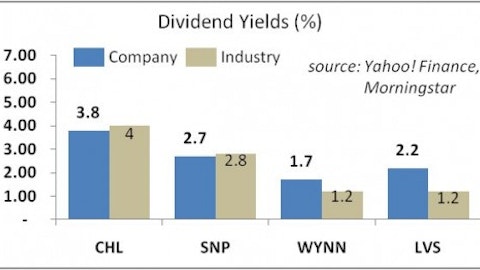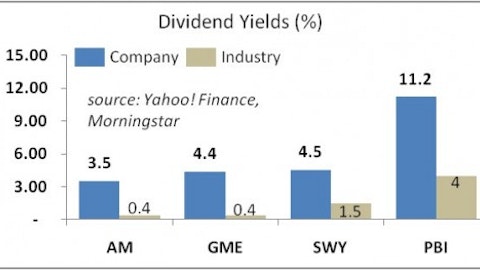We have identified five high-dividend paying financial stocks that we believe can provide stable income amid a tough economic backdrop, and during a time when financials have underperformed the broader market. The Dow Jones Industrial Average is up 50% since 2009, while the Dow Jones U.S. Financial Index is up only 40%. Our list does not include the most common banking giants, such as Bank of America, Citi, Goldman Sachs or JPMorgan because our dividend paying banks are unlike those, in that the banks we have identified have solid earnings and payout ratios. Overall, a good number of our banks are from north of the International Boundary. As banking profits have been slumping globally, Canadian banks have been taking advantage of their peers’ weaknesses by snatching up other smaller banks and distressed banks.
Our first company, Westpac Banking Corp (NYSE:WBK), pays a 6.2% dividend yield with an 81% payout ratio. The bank saw a decline of stressed assets as a percent of total committed exposures to 2.3%, and is seeing a steadying of impaired loan balances this year. Over the summer, Westpac announced that National Australia Bank had taken an almost 6% stake in the bank.
The company’s stock has been on a tear since this news broke. We see the investment by National Australia as a vote of confidence and believe there is still upside to the bank as it trades in line with other banks, at 1.8x book value, but with strong growth prospects. The fund interest in Westpac is virtually nonexistent, except two lonely fund managers Jim Simons and Ken Griffin, where Griffin took a new stake during 2Q.
Mizuho Financial Group Inc (NYSE:MFG) is a Japan-based bank holding company with a dividend yield of 5.0% and payout ratio the lowest of our five at 22%. Last quarter, Mizuho posted interest income down 1%, but net income up 91%, as the company is finding other ways to boost earnings in a low-rate environment. The bank also trades the cheapest of our five banks and below the industry average at a P/B of 0.8.
Mizuho has taken advantage of the European weakness by buying up a Brazilian unit of Germany’s WestLB, yet maintains an in-line debt to capital ratio with respect to its peers. The fund interest for Mizuho was very small for 2Q, but the company did see interest from top names such as Steven Cohen, D.E. Shaw and Jim Simons, where Simons’ position was a new one for his firm.
Bank of Montreal (NYSE:BMO) is paying a dividend that yields 4.9% with a payout of 47%. The bank operates retail banking, wealth management and investment banking units across North America. The company shows strong growth with forecasted 2012 revenues up 19% from 2011, as well as net interest income up 8.8% over this time.
S&P has a price target of $65 on the bank based on strong commercial loan growth, where the company currently only trades around $55 a share. Bank of Montreal is Canada’s fourth largest bank and North America’s eight largest the bank, and is seeking strong growth from both regions. The bank saw a couple key funds upping their stakes drastically during 2Q,with Hutchin Hill Capital increasing theirs 500% and Arrowstreet Capital boosting their position by over 1800%.
Canadian Imperial Bank of Commerce (NYSE:CM) is the fifth largest banking institution in Canada by assets and market capitalization. The bank also has a solid dividend yield of 4.9% and a 46% payout ratio. Despite a low-rate environment, the company continues to grow net interest income, with 2012’s expected to be up 4.6% from 2011, as well as 2.5% loan growth and 3.5% interest-earning asset growth.
S&P has an $80 price target on the company, with the current stock price around this level, and the historical forward P/E around 9.3x, while the company currently trades in-line at 9.4x earnings. Although growth in the interim might be limited, we believe that the almost 5% dividend makes it worth the wait. Arrowstreet and Jim Simons were also investors in Canadian Imperial, but D.E. Shaw was the fund leader with a modest 400,000 shares.
Bank of Nova Scotia (NYSE:BNS) is the third largest bank in Canada. The company pays the smallest dividend yield our five stocks at 4.3% and payout ratio of 44%. The general banking sector remains strained, but Bank of Nova Scotia expects commercial banking to carry the company in the interim, with the segment making up 22% of net income for the past year. As well, net interest income is expected to be up 11% this year from 2011.
Although the company appears overly expensive with a P/B of 2.8x, its debt to equity ratio of 0.2 puts it in a better capital position than most of the other banks listed here. Bank of Nova Scotia saw the most interest from funds of our five financial dividend payers. The bank saw Israel Englander and Arrowstreet Capital both take new positions in the company during 2Q, while D.E. Shaw upped his stake 100% and Jim Simons upped his position by 3500%. Bank of Nova Scotia’s top investor was Tetrem Capital Management, with over 3% of its firm’s 2Q 13F invested in the bank.






